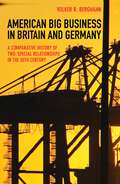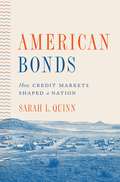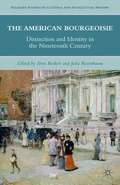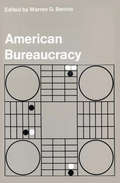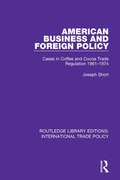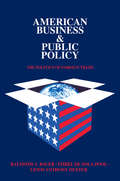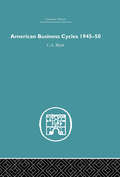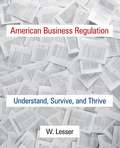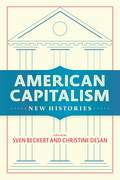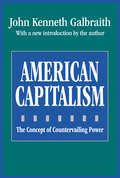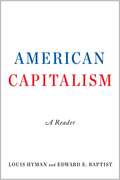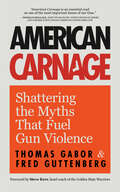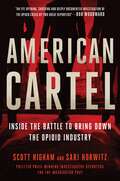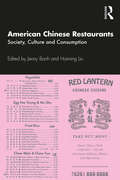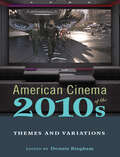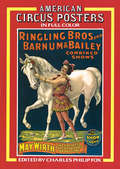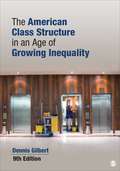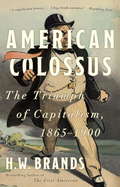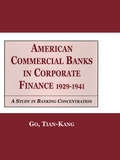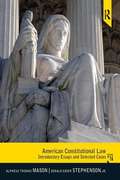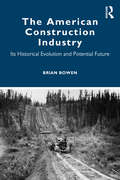- Table View
- List View
American Big Business in Britain and Germany: A Comparative History of Two "Special Relationships" in the 20th Century
by Volker R. BerghahnWhile America's relationship with Britain has often been deemed unique, especially during the two world wars when Germany was a common enemy, the American business sector actually had a greater affinity with Germany for most of the twentieth century. American Big Business in Britain and Germany examines the triangular relationship between the American, British, and German business communities and how the special relationship that Britain believed it had with the United States was supplanted by one between America and Germany.Volker Berghahn begins with the pre-1914 period and moves through the 1920s, when American investments supported German reconstruction rather than British industry. The Nazi seizure of power in 1933 led to a reversal in German-American relations, forcing American corporations to consider cutting their losses or collaborating with a regime that was inexorably moving toward war. Although Britain hoped that the wartime economic alliance with the United States would continue after World War II, the American business community reconnected with West Germany to rebuild Europe’s economy. And while Britain thought they had established their special relationship with America once again in the 1980s and 90s, in actuality it was the Germans who, with American help, had acquired an informal economic empire on the European continent.American Big Business in Britain and Germany uncovers the surprising and differing relationships of the American business community with two major European trading partners from 1900 through the twentieth century.
American Bonds: How Credit Markets Shaped a Nation (Princeton Studies in American Politics: Historical, International, and Comparative Perspectives #164)
by Sarah L. QuinnHow the American government has long used financial credit programs to create economic opportunitiesFederal housing finance policy and mortgage-backed securities have gained widespread attention in recent years because of the 2008 financial crisis, but issues of government credit have been part of American life since the nation’s founding. From the 1780s, when a watershed national land credit policy was established, to the postwar foundations of our current housing finance system, American Bonds examines the evolution of securitization and federal credit programs. Sarah Quinn shows that since the Westward expansion, the U.S. government has used financial markets to manage America’s complex social divides, and politicians and officials across the political spectrum have turned to land sales, home ownership, and credit to provide economic opportunity without the appearance of market intervention or direct wealth redistribution.Highly technical systems, securitization, and credit programs have been fundamental to how Americans determined what they could and should owe one another. Over time, government officials embraced credit as a political tool that allowed them to navigate an increasingly complex and fractured political system, affirming the government’s role as a consequential and creative market participant. Neither intermittent nor marginal, credit programs supported the growth of powerful industries, from railroads and farms to housing and finance; have been used for disaster relief, foreign policy, and military efforts; and were promoters of amortized mortgages, lending abroad, venture capital investment, and mortgage securitization.Illuminating America’s market-heavy social policies, American Bonds illustrates how political institutions became involved in the nation’s lending practices.
The American Bourgeoisie: Distinction and Identity in the Nineteenth Century
by Sven Beckert Julia B. RosenbaumThis volume engages a fundamental disciplinary question about this period in American history: how did the bourgeoisie consolidate their power and fashion themselves not simply as economic leaders but as cultural innovators and arbiters? It also explains how culture helped Americans form both a sense of shared identity and a sense of difference.
American Bureaucracy
by Warren G BennisLike it or not, contemporary man is man-in-bureaucracy. He spends the majority of his waking hours in a bureaucracy; establishes an identity and status in a bureaucracy; garners most of his satisfactions and disappointments in a bureaucracy; and, increasingly, he is what he does.Aside from the importance of understanding those institutions that shape our values, behavior, and experience, bureaucracy is a vital area for study because it reveals a wide range of social behavior in a compact and comprehensible way. The abstract and ephemeral problems of society at large are brought down to earth —made measurable, comprehensible and visible in the bureaucratic microcosm. Problems of power and influence, change and innovation, intergroup conflict, ambition and aspiration, self-realization versus participative democracy, technology versus humanism: all can be observed and analyzed in human organizations.This volume pinpoints the dilemma of present bureaucratic organizations: the conflict between the need to sustain innovation and bureaucratic drives toward rationality and stability. The essays it contains discuss specific human needs that bureaucracy must meet if it is to continue to attract talented people and takes a step into the future to analyze the kinds of organizations that may be expected to evolve as institutions seek more flexible use of human resources.
American Business and Foreign Policy: Cases in Coffee and Cocoa Trade Regulation 1961-1974 (Routledge Library Editions: International Trade Policy #1)
by Joseph ShortDeveloping countries have for many decades waged a campaign for the global regulation of trade in primary products through international commodity agreements. Heavily dependent upon exports of primary products, developing countries hope to regulate the markets for their commodities to achieve higher prices. While there is a myriad of obstacles to agreements, the blame for slow progress is often laid at the feet of the industrial, commodity-consuming countries, particularly the US. This book, first published in 1987, is a comparative case study that closely analyses how American businesses behaved in relation to US government responses to developing countries’ demands for commodity agreements for coffee and cocoa.
American Business and Public Policy: The politics of foreign trade
by Theodore DraperAmerican Business and Public Policy is a study of the politics of foreign trade. It challenges fifty years of writ-ing on pressure politics. It includes nine hundred interviews with heads of corporations, including 166 of the 200 largest corporations; another 500 interviews with congressmen, lob-byists, journalists, and opinion leaders; and eight community studies making this book the most intensive survey in print of the politics of business. It is a realistic behavioral examination of a major type of economic decision.The authors introduce their study with a history of the tariff as a political issue in American politics and a history of American tariff legislation in the years from Europe's trade recovery under the Marshall Plan to the challenge of the Common Market. They examine in succession the changing attitudes of the general public and the political actions of the business community, the lobbies, and Congress.American Business and Public Policy is a contribution to social theory in several of its branches. It is a contribution to understanding the business community, to the social psychol-ogy of communication and attitude change, to the study of political behavior in foreign policy.American Business and Public Policy is at once a study of a classic issue in American politics the tariff; decision-making, particularly the relation of economic to social-psycho-logical theories of behavior; business communication what businessmen read about world affairs, what effect foreign travel has on them, where they turn for political advice, and how they seek political help; pressure politics, lobbying, and the Congressional process.
American Business Cycles 1945-50
by Conrad BlythAfter the end of the Second World War businessmen and economists throughout the world feared that the American postwar inflationary boom would end in a serious slump. The slump took a long time to come, and when it did appear in 1949 it was both mild and short lived. In its mildness and brevity it foreshadowed the American business recessions since that time and, indeed, may foreshadow the end of the business cycle as it has been known in the past. This book presents the first full-scale study of the 1948–49 recession in the United States, making it the focal point of a detailed, analytical account of American business fluctuations from the end of the Second World War until the beginning of the Korean War. The main part of the book is prefaced by a review of fluctuations from 1945 to 1967 and of the business cycle theory, which places the postwar events in perspective. Of special importance are the studies of the ending, in early 1948, of the period of re-stocking and re-equipment; of the impact of the changed farm situation in this deflationary atmosphere, and use of modern consumption theory to explain the changes in household spending after the war and during the recession. Dr. Blyth has drawn extensively upon the results of modern economic research, and has woven the econometric findings and the historical narrative together with a theoretical analysis. He conclusively rejects the theory that recent U.S. business cycles are the result of any largely self-perpetuating fluctuation in investment in stocks. Instead he draws attention to the persistent destabilizing roles of changes in defense expenditure and of changes in monetary policy-inventory investment performs the largely passive role of aggravating these changes. The book, first published in 1969, will be of value not only to specialists in business cycle studies, but to economists and others concerned with the problems of stability and growth in the international economy, as well as to economic historians.
American Business Regulation: Understand, Survive and Thrive
by William LesserWhile there are lengthy texts discussing the economics of why and how governments regulate business and apply antitrust, this book is unique in providing the details of current business regulation in many industries through lengthy examples the author develops with the use of cases, including Harvard Business School cases. Students are then guided to devise business strategies of introducing new products within the scope of regulation (known or unknown). While the economic theories of regulation are covered, the focus of this text is a "hands-on coping" with regulation and using regulation as a business strategy to deal with competitors. Online instructor's materials are also available for adopters.
American Cancer Society: Access to Care
by Kathryn Rosenberg Robert L. SimonsCEO John Seffrin decides to radically change the strategy of the American Cancer Society. The new Access to Care strategy relies on advocacy to change public policy and increase the number of Americans eligible for cancer prevention and treatment. The new strategy brings with it considerable political risk. Leveraging an organization with 3 million volunteers, this case describes how he skillfully transforms the organization (structure, control systems, staff, shared values, etc.) to implement the new strategy.
American Capitalism: New Histories (Columbia Studies in the History of U.S. Capitalism)
by Edited by Sven Beckert Christine DesanThe United States has long epitomized capitalism. From its enterprising shopkeepers, wildcat banks, violent slave plantations, huge industrial working class, and raucous commodities trade to its world-spanning multinationals, its massive factories, and the centripetal power of New York in the world of finance, America has come to symbolize capitalism for two centuries and more. But an understanding of the history of American capitalism is as elusive as it is urgent. What does it mean to make capitalism a subject of historical inquiry? What is its potential across multiple disciplines, alongside different methodologies, and in a range of geographic and chronological settings? And how does a focus on capitalism change our understanding of American history?American Capitalism presents a sampling of cutting-edge research from prominent scholars. These broad-minded and rigorous essays venture new angles on finance, debt, and credit; women’s rights; slavery and political economy; the racialization of capitalism; labor beyond industrial wage workers; and the production of knowledge, including the idea of the economy, among other topics. Together, the essays suggest emerging themes in the field: a fascination with capitalism as it is made by political authority, how it is claimed and contested by participants, how it spreads across the globe, and how it can be reconceptualized without being universalized. A major statement for a wide-open field, this book demonstrates the breadth and scope of the work that the history of capitalism can provoke.
American Capitalism: The Concept of Countervailing Power
by John GalbraithIn his new introduction to this classic text on political economy, Galbraith reasserts the validity of the core thesis of American Capitalism: The best and established answer to economic power is the building of countervailing power. The trade union remains an equalizing force in the labor markets, and the chain store is the best answer to the market power of big food companies. This work remains an essential guidepost of American mores as well as that as of the American economy.
American Capitalism: A Reader
by Louis Hyman Edward E. Baptist"Welcome to this collection of important documents and essays about the history of American capitalism. We hope you will find these to be useful supplements to courses on the history of capitalism in the United States and elsewhere. There is no one right way to read this book, and no one right way to use it as part of a course. We only hope that you will find these readings as illuminating as we have found them. Taken together, these are the bricks and mortar that allowed us to build more than a class about a specific subject, taught in a specific format. In fact, they have enabled us to shape our understandings of how capitalism has developed and changed and how it continues to change in the United States--and how those developments and changes shape lives, here and in the rest of the world." From the forward.
American Carnage: Shattering the Myths That Fuel Gun Violence
by Thomas Gabor Fred GuttenbergShooting Down Gun Violence Misinformation"Don't tell me there's no such thing as gun violence. It happened in Parkland." ―Fred Guttenberg#1 Best Seller in School Safety, Education Policy, and Law Enforcement PoliticsFred Guttenberg, who lost his beloved daughter Jaime in the 2018 Parkland school shooting, and International gun policy consultant Thomas Gabor team up in American Carnage to dismantle some of the most common myths about guns and gun violence.A national disgrace. In America, over 40,000 die each year as a result of gun violence. Relative to other advanced countries, the U.S. has a dismal gun violence record. Gun law reforms could reduce the number of gun deaths, but many political challenges stand in the way. A widespread multi-year misinformation assault on truth by the gun lobby and gun-extremists sows doubt about the dangers of pervasive gun ownership, gun carrying, and potential effectiveness of gun laws.Debunking popular gun myths. Countering with strong evidence-based research the many slogans and myths repeated incessantly by spokespersons for the gun lobby and its surrogates is essential if we are to have a society where kids can attend school safely and people can work and enjoy life without fear of being shot. Over the last 30 years, the NRA’s campaign to achieve an armed society has succeeded in persuading many Americans that having a gun in the home or carrying a gun makes them safer. The evidence is overwhelming this is not the case. Guns in the home are far more likely to be used against a family member or in a suicide attempt than against an intruder. Tackling this and other myths is critical.Myths and slogans exposed as false in American Carnage include:Gun owners frequently use firearms to fend off attackersAn armed society is a safer societyGuns don’t kill people, people kill peopleIf you have read Trigger Points, The Violence Project, Warning Signs, or Fred Guttenberg’s Find the Helpers, American Carnage is a must read.
American Cartel: Inside the Battle to Bring Down the Opioid Industry
by Scott Higham Sari HorwitzThe definitive investigation and exposé of how some of the nation's largest corporations created and fueled the opioid crisis—from the Pulitzer Prize-winning Washington Post reporters who first uncovered the dimensions of the deluge of pain pills that ravaged the country and the complicity of a near-omnipotent drug cartel. AMERICAN CARTEL is an unflinching and deeply documented dive into the culpability of the drug companies behind the staggering death toll of the opioid epidemic. It follows a small band of DEA agents led by Joseph Rannazzisi, a tough-talking New Yorker who had spent a storied thirty years bringing down bad guys; along with a band of lawyers, including West Virginia native Paul Farrell Jr., who fought to hold the drug industry to account in the face of the worst man-made drug epidemic in American history. It is the story of underdogs prevailing over corporate greed and political cowardice, persevering in the face of predicted failure, and how they found some semblance of justice for the families of the dead during the most complex civil litigation ever seen.The investigators and lawyers discovered hundreds of thousands of confidential corporate emails and memos during courtroom combat with legions of white-shoe law firms defending the opioid industry. One breathtaking disclosure after another—from emails that mocked addicts to invoices chronicling the rise of pill mills—showed the indifference of big business to the epidemic&’s toll. The narrative approach echoes such work as A Civil Action and The Insider, moving dramatically between corporate boardrooms, courthouses, lobbying firms, DEA field offices, and Capitol Hill while capturing the human toll of the epidemic on America&’s streets.AMERICAN CARTEL is the story of those who were on the front lines of the fight to stop the human carnage. Along the way, they suffer a string of defeats, some of their careers destroyed by the very same government officials who swore to uphold the law before they begin to prevail over some of the most powerful corporate and political influences in the nation.
American Chemical Corp.
by John P. Goldsberry William E. FruhanA large chemical manufacturer divests a plant that is acquired by a small specialty chemicals manufacturer. The acquisition decision is viewed from the vantage point of the small specialty chemicals manufacturer.
American Chinese Restaurants: Society, Culture and Consumption
by Haiming Liu Jenny BanhWith case studies from the USA, Canada, Chile, and other countries in Latin America, American Chinese Restaurants examines the lived experiences of what it is like to work in a Chinese restaurant. The book provides ethnographic insights on small family businesses, struggling immigrant parents, and kids working, living, and growing up in an American Chinese restaurant. This is the first book based on personal histories to document and analyze the American Chinese restaurant world. New narratives by various international and American contributors have presented Chinese restaurants as dynamic agencies that raise questions on identity, ethnicity, transnationalism, industrialization, (post)modernity, assimilation, public and civic spheres, and socioeconomic differences. American Chinese Restaurants will be of interest to general readers, scholars, and college students from undergraduate to graduate level, who wish to know Chinese restaurant life and understand the relationship between food and society.
American Cinema of the 2010s: Themes and Variations (Screen Decades: American Culture/American Cinema)
by Dennis Bingham Michele Schreiber David Greven Raymond Haberski Jr. Alexandra Keller Daniel Smith-Rowsey Lisa Bode Cynthia Baron Julie Levinson Mikal J. GainesThe 2010s might be remembered as a time of increased polarization in American life. The decade contained both the Obama era and the Trump era, and as the nation’s political fissures widened, so did the gap between the haves and have-nots. Hollywood reflected these divisions, choosing to concentrate on big franchise blockbusters at the expense of mid-budget films, while new players like Netflix and Amazon offered fresh opportunities for low-budget and independent filmmakers. As the movie business changed, films ranging from American Sniper to Get Out found ways to speak to the concerns of a divided nation. The newest installment in the Screen Decades series, American Cinema in the 2010s takes a close look at the memorable movies, visionary filmmakers, and behind-the-scenes drama that made this decade such an exciting time to be a moviegoer. Each chapter offers an in-depth examination of a specific year, covering a wide variety of films, from blockbuster superhero movies like Black Panther and animated films like Frozen to smaller-budget biopics like I, Tonya and horror films like Hereditary. This volume introduces readers to a decade in which established auteurs like Quentin Tarantino were joined by an exceptionally diverse set of new talents, taking American cinema in new directions.
American Circus Posters
by Charles Philip FoxThe Children's Dream of Fairy-Land (1893) . . . Living Statues on Horseback (1890s) . . . Real Roman Hippodrome, Five Continent Menagerie (1890s) . . . Uno, Queen Supreme of the Serpent Kingdom (1894) . . . Dancing Girls, Mounted Guards and Truly Lavish Displays (1903) . . . "Twisting Double Somersault," A Feat Never Before Attempted by the Most Intrepid Aerialists (1904) . . . Desperado's Terrible Leap for Life, A Terrific Descent of 80 Feet Through Space Landing Upon His Chest on a Skid (1909) . . . The Imperial Chinese Circus Stars (1914) . . . An Army of Clowns (1920s) . . . Pallenberg's Wonder Bears (1920s) . . . Gargantua the Great (1938).Originally put in store windows and posted on sheds, barns, buildings, walls and fences, these 18 extremely rare posters, most not previously reproduced, are collected together for the first time. The quality of reproduction is superb: reproduced in full color directly from the originals, these posters have been printed in an extra large format and on coated stock so that every detail is clear. They are an exciting visual history, capturing the pageantry and color that the circus was and is. They are also extremely fine examples of almost 50 years of poster art and American advertising. There are acrobats, elephants, tigers, lions, parades, tents, trains, and many specialized acts: May Wirth, the Riding Rooneys, the Astounding Clarkonians, etc. The posters date from the 1890s to the 1940s, and include one by Norman Bel Geddes. They feature many American circuses: Ringling Bros., Barnum & Bailey, Sells, Sparks, Hagenbeck-Wallace. The historical introduction and captions are by Charles Philip Fox, Director of Research and Development with the Ringling Bros. and Barnum & Bailey Circus.
The American Class Structure in an Age of Growing Inequality (Ninth Edition)
by Dennis L. GilbertLike its predecessors, the Ninth Edition of Dennis Gilbert's The American Class Structure in an Age of Growing Inequality, focuses on the socioeconomic core of the American class system. Drawing on classic and contemporary studies, Gilbert describes our class structure and shows how class affects our everyday lives, from the way we raise our children to the way we vote. The major theme running through the book is the increasing inequality in American society. Gilbert describes the shift in the mid-1970s from an "Age of Shared Prosperity" to an "Age of Growing Inequality. " Using the most recent wage, income, and wealth statistics, and accounts of the shifting balance of class power in national politics, the author traces the widening disparities between the privileged classes and average Americans. He repeatedly returns to the question, "Why is this happening?" A variety of economic, political, and social factors are examined, and the competing explanations of influential writers are critically assessed, concluding with the author's synthesis of the book's lessons about the power of class and the forces behind growing inequality.
American Colossus: The Triumph of Capitalism, 1865-1900
by H. W. BrandsIn a grand-scale narrative history, the bestselling author of two finalists for the Pulitzer Prize now captures the decades when capitalism was at its most unbridled and a few breathtakingly wealthy businessmen utterly transformed America from an agrarian economy to a world power. The years between the Civil War and the end of the nineteenth century saw the wholesale transformation of America from a land of small farmers and small businessmen into an industrial giant. Driven by unfathomably wealthy and powerful businessmen like J. P. Morgan, Andrew Carnegie and John D. Rockefeller, armies of workers, both male and female, were harnessed to a new vision of massive industry. A society rooted in the soil became one based in cities, and legions of immigrants were drawn to American shores. What's more, in accomplishing its revolution, capitalism threatened to eclipse American democracy. "What do I care about the law?" bellowed Cornelius Vanderbilt. "Hain't I got the power?" He did, and with it he and the other capitalists reshaped every aspect of American life. InAmerican Colossus,H. W. Brands portrays the emergence, in a remarkably short time, of a recognizably modern America. The capitalist revolution left not a single area or aspect of American life untouched. It roared across the South, wrenching that region from its feudal past and integrating the southern economy into the national one. It burst over the West, dictating the destruction of Native American economies and peoples, driving the exploitation of natural resources, and making the frontier of settlement a business frontier as well. It crashed across the urban landscape of the East and North, turning cities into engines of wealth and poverty, opulence and squalor. It swamped the politics of an earlier era, capturing one major party and half of the other, inspiring the creation of a third party and determining the issues over which all three waged some of the bitterest battles in American history. Brands's spellbinding narrative beautifully depicts the oil gushers of western Pennsylvania, the rise, in Chicago, of the first skyscraper, the exploration of the Colorado River, the cattle drives of the West, and the early passionate sparks of union life. By 1900 the America he portrays is wealthier than ever, yet prosperity is precarious, inequality rampant, and democracy stretched thin. American Colossusis an unforgettable portrait of the years when the contest between capitalism and democracy was at its sharpest, and capitalism triumphed. From the Hardcover edition.
American Commercial Banks in Corporate Finance, 1929-1941: A Study in Banking Concentrations (Garland Studies In The Financial Sector Of The Economy)
by Go Kang TiaFirst published in 1999. Routledge is an imprint of Taylor & Francis, an informa company.
American Connector Co. (A)
by Gary P. Pisano Sharon RossiAmerican Connector Co. is forced to reexamine operations at its Sunnyvale plant when a Japanese competitor announces plans to build an "ultimate" plant in the United States. Case examines issues related to benchmarking a competitor's manufacturing capabilities and productivity. Allows students to compare two companies' manufacturing strategies and their implications for productivity and flexibility.
American Connector Co. (B)
by Gary P. PisanoPresents a plant manager's proposal to improve operations at American Connector Co. The plan attempts to imitate operations at DJC Corp., a successful Japanese competitor. Requires students to consider how changes in manufacturing impact productivity, flexibility, and overall strategy.
American Constitutional Law: Introductory Essays and Selected Cases
by Alpheus Thomas Mason Grier StephensonThis classic collection of carefully selected and edited Supreme Court case excerpts and comprehensive background essays explores constitutional law and the role of the Supreme Court in its development and interpretation. Well-grounded in both theory and politics, it endeavors to heighten students' understanding of and interest in these critical areas of our governmental system.
The American Construction Industry: Its Historical Evolution and Potential Future
by Brian BowenThe American Construction Industry meticulously chronicles the evolution of the construction industry from its roots in the medieval guild system to the high-tech jobsite of tomorrow. While celebrating more than two millennia of progress and innovation, this resource for students and professionals uncovers the ways of working that crossed the Atlantic with the earliest European settlers and will continue to define building trades in the United States today and in the years and decades to come. Full color illustrations bring the past to life and provide visual links to the present day.
